Themed collection Scanning Probe Studies of Molecular Systems

Growth of boronic acid based two-dimensional covalent networks on a metal surface under ultrahigh vacuum
An extensive analysis of the complex mechanisms governing the on-surface polymerisation of boronic acid on a metal surface under vacuum.

Chem. Commun., 2014,50, 9627-9635
https://doi.org/10.1039/C4CC02678K
Studying the dynamic behaviour of porphyrins as prototype functional molecules by scanning tunnelling microscopy close to room temperature
Scanning tunnelling microscopy of the dynamics of functional molecules (porphyrins) close to room temperature enables a detailed determination of the thermodynamic potentials including entropic contributions of the underlying processes.
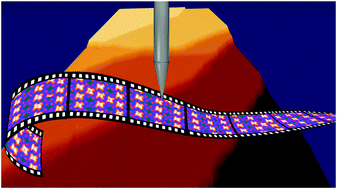
Chem. Commun., 2014,50, 9034-9048
https://doi.org/10.1039/C4CC01744G
Bestowing structure upon the pores of a supramolecular network
Trigonal molecules compartmentalise the pores of a supramolecular honeycomb network.
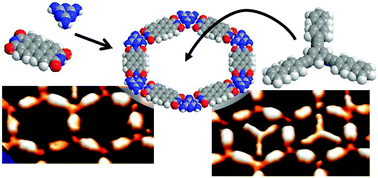
Chem. Commun., 2014,50, 14175-14178
https://doi.org/10.1039/C4CC05934D
Self-assembly of pyrene derivatives on Au(111): substituent effects on intermolecular interactions
Halogen bonding-based self-assembly of pyrene derivatives on Au(111).
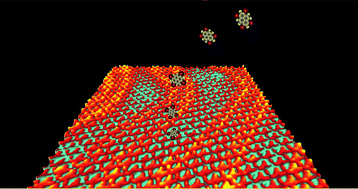
Chem. Commun., 2014,50, 14089-14092
https://doi.org/10.1039/C4CC02753A
Biaxial aromatics with face-on/edge-on stacking adaptability: an STM/STS study of 1D nanowires assembled via rotatable ethynyls
Biaxial aromatics with face-on/edge-on stacking adaptability.
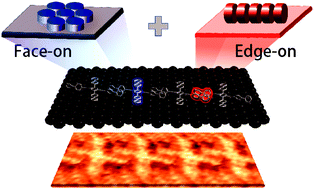
Chem. Commun., 2014,50, 14093-14096
https://doi.org/10.1039/C4CC02704C
Van der Waals interactions in the self-assembly of 5-amino[6]helicene on Cu(100) and Au(111)
No H bonding for the amino group: van der Waals interactions guide the self-assembly of an aminohelicene on Cu(100) and Au(111).
![Graphical abstract: Van der Waals interactions in the self-assembly of 5-amino[6]helicene on Cu(100) and Au(111)](/en/Image/Get?imageInfo.ImageType=GA&imageInfo.ImageIdentifier.ManuscriptID=C4CC04338C&imageInfo.ImageIdentifier.Year=2014)
Chem. Commun., 2014,50, 13907-13909
https://doi.org/10.1039/C4CC04338C
Hierarchical growth of curved organic nanowires upon evaporation induced self-assembly
Hierarchical growth of multilayers and complex curved nanostructures including nanospirals and concentric nanorings upon evaporation of a solution.
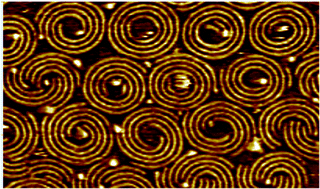
Chem. Commun., 2014,50, 13216-13219
https://doi.org/10.1039/C4CC03676J
Playing peekaboo with graphene oxide: a scanning electrochemical microscopy investigation
Electrostatic interactions with the molecular mediator control imaging of graphene oxide by scanning electrochemical microscopy.
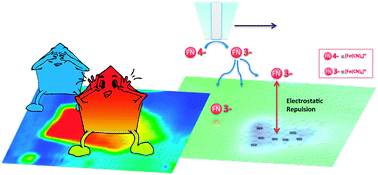
Chem. Commun., 2014,50, 13117-13120
https://doi.org/10.1039/C4CC06368F
Probing the spatial and momentum distribution of confined surface states in a metal coordination network
We show how the surface state is confined and modulated by the porous structure of a metal-coordinated dicyano-anthracene on-surface network on Cu(111), as evidenced by scanning tunnelling microscopy and spectroscopy measurements in real and reciprocal space.
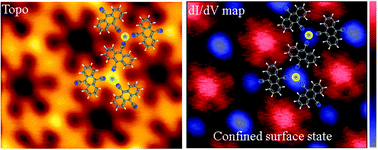
Chem. Commun., 2014,50, 12289-12292
https://doi.org/10.1039/C4CC03941F
Synthesis of polydopamine at the femtoliter scale and confined fabrication of Ag nanoparticles on surfaces
Polydopamine is synthesized in confined femtolitre sized droplets and used as green nanoreactors to fabricate Ag nanoparticles on surfaces.

Chem. Commun., 2014,50, 12548-12551
https://doi.org/10.1039/C4CC02500H
Molecular tectonics based nanopatterning of interfaces with 2D metal–organic frameworks (MOFs)
The nanostructuring of the graphite surface with 2DMOF, based on a combination of an acentric porphyrin tecton and a CoCl2 metallatecton, was achieved at the solid–liquid interface and characterized by scanning tunnelling microscopy.
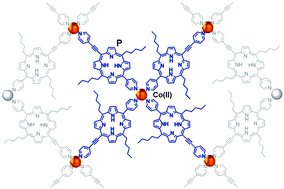
Chem. Commun., 2014,50, 12250-12253
https://doi.org/10.1039/C4CC03622K
Affecting surface chirality via multicomponent adsorption of chiral and achiral molecules
Here we report on the apparent reduction in surface chirality upon co-assembling a chiral and achiral molecule into a physisorbed self-assembled monolayer at the liquid/solid interface as revealed by scanning tunneling microscopy (STM).
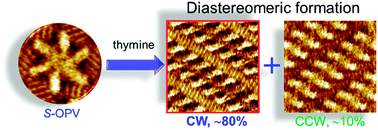
Chem. Commun., 2014,50, 11903-11906
https://doi.org/10.1039/C4CC04393F
Efficient molecular recognition based on nonspecific van der Waals interaction at the solid/liquid interface
A surprising recognition phenomenon based on van der Waals interactions was observed, which proves that the design of the supramolecular assembly from its building blocks represents a highly promising and general strategy.
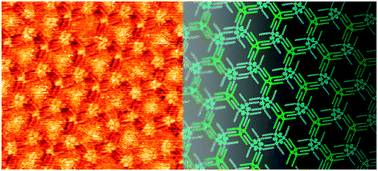
Chem. Commun., 2014,50, 11946-11949
https://doi.org/10.1039/C4CC03658A
Cyclotrimerization of arylalkynes on Au(111)
Cyclotrimerization of arylalkynes on Au(111) proceeds readily at modest temperatures, and affords two-dimensional covalently bonded polyphenylene networks.

Chem. Commun., 2014,50, 11200-11203
https://doi.org/10.1039/C4CC02859G
Thermally activated polymorphic transition from a 1D ribbon to a 2D carpet: squaric acid on Au(111)
Polymorphic transition from the 1D ribbon to the 2D carpet superstructure of squaric acid molecules on Au(111) was achieved through a thermally activated process.
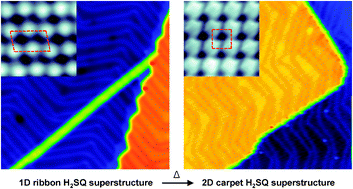
Chem. Commun., 2014,50, 11230-11233
https://doi.org/10.1039/C4CC05794E
Bicomponent hydrogen-bonded nanostructures formed by two complementary molecular Landers on Au(111)
One- and two-dimensional structures formed by two Lander molecules on Au(111) via 3D-optimized or complementary triple H-bonding are studied by scanning tunneling microscopy and rationalized by numerical calculations.
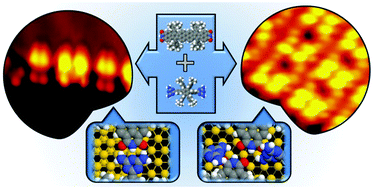
Chem. Commun., 2014,50, 10619-10621
https://doi.org/10.1039/C4CC03550J
Potential-driven molecular tiling of a charged polycyclic aromatic compound
Electrochemical potential causes molecular tiling of organic ions at the solid–liquid interface with supramolecular motifs that contain between 2 and 7 tectons.
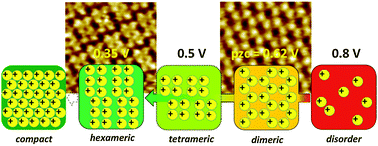
Chem. Commun., 2014,50, 10376-10378
https://doi.org/10.1039/C4CC04189E
Comparative STM studies of mixed ligand monolayers on gold nanoparticles in air and in 1-phenyloctane
Scanning tunnelling microscopy (STM) studies have found that stripe-like domains on gold nanoparticles (NPs) have the same characteristic length in air and in 1-phenyloctane.
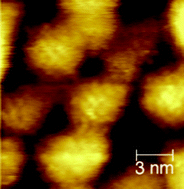
Chem. Commun., 2014,50, 10456-10459
https://doi.org/10.1039/C4CC04114C
Hydrogen-bonded clusters of ferrocenecarboxylic acid on Au(111)
A STM image of ferrocenecarboxylic acid clusters on Au(111), showing molecular clusters with both double-row and regular pentagonal geometries.
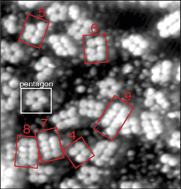
Chem. Commun., 2014,50, 10229-10232
https://doi.org/10.1039/C4CC03664F
Massive conformational changes during thermally induced self-metalation of 2H-tetrakis-(3,5-di-tert-butyl)-phenylporphyrin on Cu(111)
2HTTBPP on Cu(111) behaves almost like a loaded spring which is held by the strong attractive interactions of the iminic nitrogens with the Cu substrate and is released upon metalation.
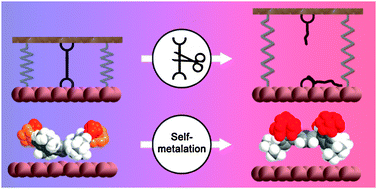
Chem. Commun., 2014,50, 10225-10228
https://doi.org/10.1039/C4CC03708A
Nanoscale insight into C–C coupling on cobalt nanoparticles
A molecular-scale view of efficient and selective homocoupling of both aryl and benzyl groups on cobalt nanoparticles.
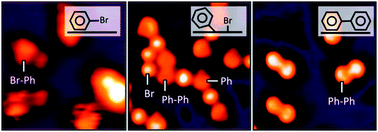
Chem. Commun., 2014,50, 10035-10037
https://doi.org/10.1039/C4CC03678F
Anion-induced dimerization of 5-fold symmetric cyanostars in 3D crystalline solids and 2D self-assembled crystals
Anions stabilize stacking of C5-symmetric macrocycles, called cyanostars, into dimers in solution, in solid-state crystals, and in bilayers at the solution–graphite interface.
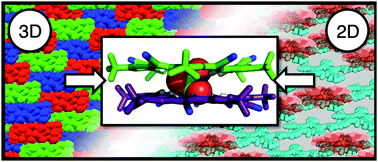
Chem. Commun., 2014,50, 9827-9830
https://doi.org/10.1039/C4CC03725A
Convergent and divergent two-dimensional coordination networks formed through substrate-activated or quenched alkynyl ligation
Ni–alkynyl coordination can be quenched or activated depending on the metal surface leading to long-range ordered or random networks, respectively.
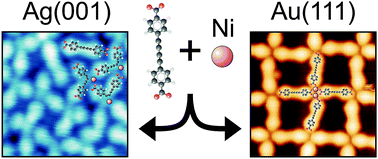
Chem. Commun., 2014,50, 9973-9976
https://doi.org/10.1039/C4CC03723E
An STM study of molecular exchange processes in organic thin film growth
PCBM molecules deposited on an exTTF layer grown on Au(111) exchange places with the exTTF molecules, expelling them to the outer surface, even at 150 K, when the surface diffusion of the exTTF molecules is completely frozen.

Chem. Commun., 2014,50, 9954-9957
https://doi.org/10.1039/C4CC03656E
Nano-scale characterization of binary self-assembled monolayers under an ambient condition with STM and TERS
Gold surfaces were modified by benzyl-mercaptan (BM) and then partly replaced with benzenethiol (BT), which formed binary self-assembled monolayers (SAM).
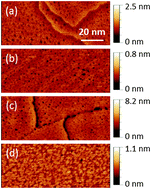
Chem. Commun., 2014,50, 9862-9864
https://doi.org/10.1039/C4CC02754J
A silver nanowire-based tip suitable for STM tip-enhanced Raman scattering
A chemically synthesized silver nanowire was used for atomic-resolution STM imaging and tip-enhanced Raman scattering (TERS) spectroscopy, yielding excellent reproducibility.
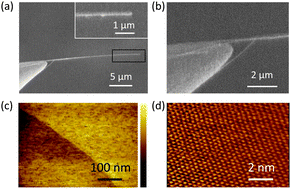
Chem. Commun., 2014,50, 9839-9841
https://doi.org/10.1039/C4CC02750G
Controlling two-phase self-assembly of an adenine derivative on HOPG via kinetic effects
Large-area self-assembled structures of a nucleobase adenine derivative were successfully realized through vacuum deposition.
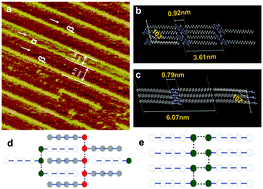
Chem. Commun., 2014,50, 9192-9195
https://doi.org/10.1039/C4CC03714F
Bimolecular porous supramolecular networks deposited from solution on layered materials: graphite, boron nitride and molybdenum disulphide
Solution deposition and molecular resolution AFM of bimolecular supramolecular networks on layered materials including the insulating boron nitride surface.
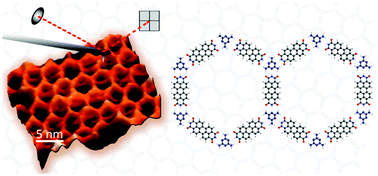
Chem. Commun., 2014,50, 8882-8885
https://doi.org/10.1039/C4CC03720K
Transformation of β-sheet structures of the amyloid peptide induced by molecular modulators
In this work we report the controlled modulation of secondary structures of the amyloid peptide by terminus molecular modulators.
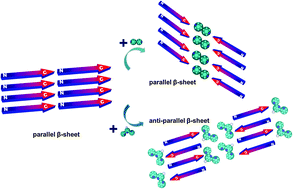
Chem. Commun., 2014,50, 8923-8926
https://doi.org/10.1039/C4CC02748E
Concentration dependent halogen-bond density in the 2D self-assembly of a thienophenanthrene derivative at the aliphatic acid/graphite interface
The supramolecular patterns of a thienophenanthrene derivative could be switched between dissimilar polymorphs with different halogen-bond densities by solution concentration at the aliphatic acid/graphite interface.
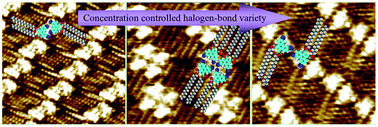
Chem. Commun., 2014,50, 9003-9006
https://doi.org/10.1039/C4CC03687E
Self-assembled organic monolayers on epitaxial graphene with enhanced structural and thermal stability
Perylenetetracarboxylic diimide forms well-ordered self-assembled monolayers on epitaxial graphene with enhanced structural and thermal stability compared to previous perylene-based compounds.
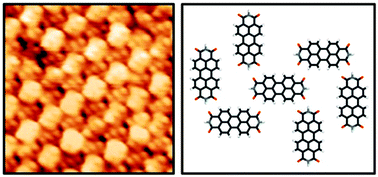
Chem. Commun., 2014,50, 8852-8855
https://doi.org/10.1039/C4CC02761B
2D conglomerate crystallization of heptahelicene
Two-dimensional homochiral nucleation and conglomerate crystallization of an unsubstituted all-carbon helicene on a metal surface is observed for the first time.
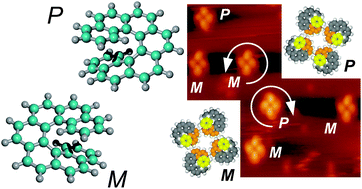
Chem. Commun., 2014,50, 8751-8753
https://doi.org/10.1039/C4CC03574G
Tip-induced C–H activation and oligomerization of thienoanthracenes
The tip of a scanning tunneling microscope (STM) can be used to dehydrogenate freely-diffusing tetrathienoanthracene (TTA) molecules on Cu(111), trapping the molecules into metal-coordinated oligomeric structures.
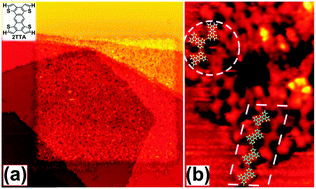
Chem. Commun., 2014,50, 8791-8793
https://doi.org/10.1039/C4CC03719G
Kagome-like lattice of π–π stacked 3-hydroxyphenalenone on Cu(111)
Three-dimensional arrangement of 3-HPLN on a 2D surface, involving π–π stacking and perpendicular molecule attachment, results in a Kagome lattice.
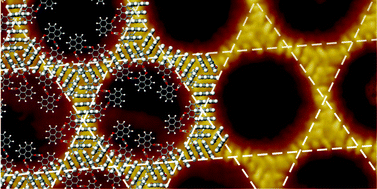
Chem. Commun., 2014,50, 8659-8662
https://doi.org/10.1039/C4CC03523B
Adsorption and reaction of sub-monolayer films of an ionic liquid on Cu(111)
The reactive interaction of the ionic liquid 1-butyl-1-methylpyrrolidinium bis(trifluoromethylsulfonyl)imide [BMP][TFSA] with Cu(111) was investigated by scanning tunnelling microscopy (STM) and X-ray photoelectron spectroscopy (XPS) under ultrahigh vacuum (UHV) conditions.
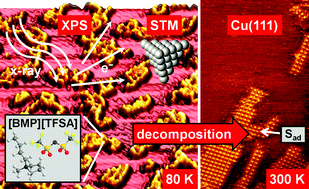
Chem. Commun., 2014,50, 8601-8604
https://doi.org/10.1039/C4CC03203A
Step-by-step on-surface synthesis: from manganese phthalocyanines to their polymeric form
On-surface reaction of tetracyanobenzene molecules with Mn atoms is presented.

Chem. Commun., 2014,50, 8565-8567
https://doi.org/10.1039/C4CC02792B
Coordination reaction between tetraphenylporphyrin and nickel on a TiO2(110) surface
Reaction of tetraphenylporphyrin with nickel on TiO2(110) results in the formation of nickel(II)-tetraphenylporphyrin and a 45° rotation of the molecule.
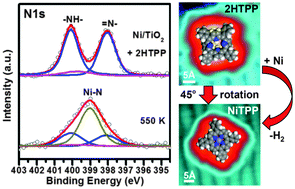
Chem. Commun., 2014,50, 8291-8294
https://doi.org/10.1039/C4CC02919D
Covalent, sequence-specific attachment of long DNA molecules to a surface using DNA-templated click chemistry
We present a novel method that covalently and sequence-specifically attaches long DNA molecules to a surface that is compatible with high-resolution atomic force microscopy (AFM) imaging.

Chem. Commun., 2014,50, 8131-8133
https://doi.org/10.1039/C4CC02900C
Covalent assembly of a two-dimensional molecular “sponge” on a Cu(111) surface: confined electronic surface states in open and closed pores
We present a new class of on-surface covalent reactions, formed between diborylene-3,4,9,10-tetraaminoperylene and trimesic acid on Cu(111), which gives rise to a porous 2D-‘sponge’.
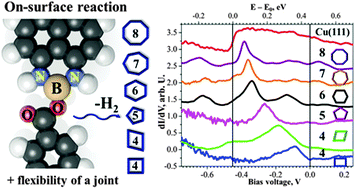
Chem. Commun., 2014,50, 7628-7631
https://doi.org/10.1039/C4CC02463J
On-surface Ullmann polymerization via intermediate organometallic networks on Ag(111)
The role of organometallic intermediates during on-surface polymerization via Ullmann coupling was studied on Ag(111).
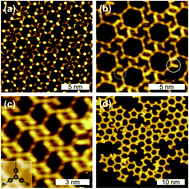
Chem. Commun., 2014,50, 7680-7682
https://doi.org/10.1039/C4CC02757D
Growth dynamics in supersonic molecular beam deposition of pentacene sub-monolayers on SiO2
Studying highly energetic pentacene impinging on a surface, we demonstrated that the perpendicular component of the momentum drives the nucleation process, while the parallel component governs the sticking coefficient and the island fractality.
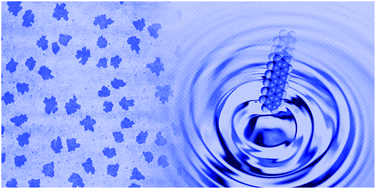
Chem. Commun., 2014,50, 7694-7697
https://doi.org/10.1039/C4CC01656D
Dynamic rearrangement of bilayers of porphyrin hetero-dimers at a solid/liquid interface
Porphyrin hetero-dimers self-assemble into bilayers that dynamically rearrange at a solid/liquid interface.
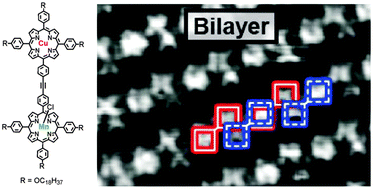
Chem. Commun., 2014,50, 7291-7294
https://doi.org/10.1039/C4CC02963A
Height dependent molecular trapping in stacked cyclic porphyrin nanorings
Stacked cyclic porphyrin nanorings function as traps for fullerene molecules dependent on stack height and diameter of the nanoring.
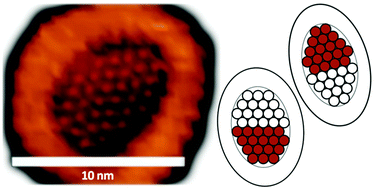
Chem. Commun., 2014,50, 7332-7335
https://doi.org/10.1039/C4CC02629B
Segregation of Fischer–Tropsch reactants on cobalt nanoparticle surfaces
Scanning tunnelling microscopy reveals segregation of carbon monoxide and hydrogen, the two Fischer–Tropsch synthesis reactants, on cobalt nanoparticles at catalytically relevant coverages. Density functional theory calculations elucidate the energetics.
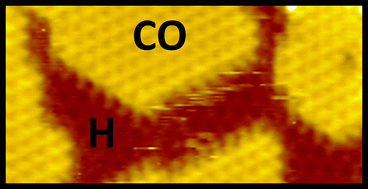
Chem. Commun., 2014,50, 6537-6539
https://doi.org/10.1039/C4CC01680G
Supramolecular self-assembly of brominated molecules on a silicon surface
Hydrogen and halogen bonds have been associated for the growth of 2D compact supramolecular networks on a silicon surface.
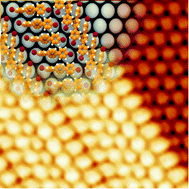
Chem. Commun., 2014,50, 5714-5716
https://doi.org/10.1039/C4CC01158A
Anisotropic growth of the thiophene-based layer on Si(111)–B
Large scale STM simulation of an anisotropic array of thiophene-based molecules on Si(111)–B.
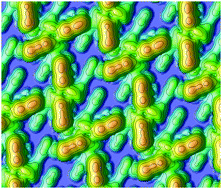
Chem. Commun., 2014,50, 5484-5486
https://doi.org/10.1039/C4CC01674B
Harnessing by a diacetylene unit: a molecular design for porous two-dimensional network formation at the liquid/solid interface
Alkoxy dehydro[12]annulene derivatives harnessed by a diacetylene unit in each alkyl chain formed porous two-dimensional networks at the liquid–graphite interface.
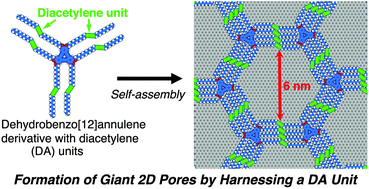
Chem. Commun., 2014,50, 2831-2833
https://doi.org/10.1039/C3CC47949H
A metal surface with chiral memory
Prochiral molecules locally induce a chiral restructuring of the Cu(110) surface that persists after removal of the molecules.
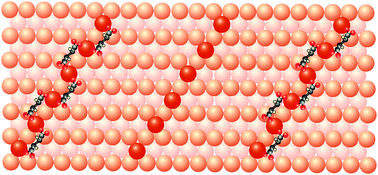
Chem. Commun., 2014,50, 1814-1816
https://doi.org/10.1039/C3CC48797K
About this collection
This ChemComm themed collection, guest edited by Steven De Feyter, Nian Lin, Steven Tait, showcases the latest research covering all aspects of high resolution scanning probe microscopy (SPM) experiments of organic and inorganic molecules at surfaces. New articles will be added to this collection as they are published.